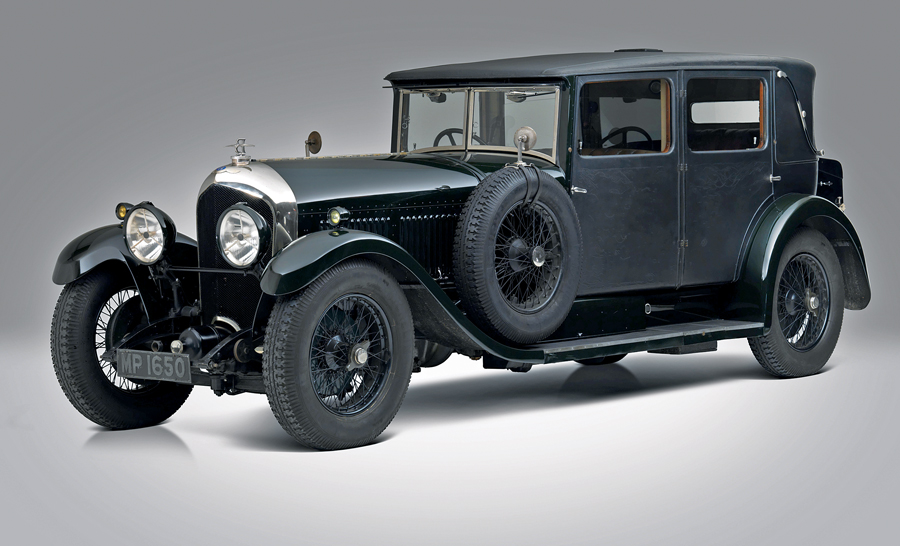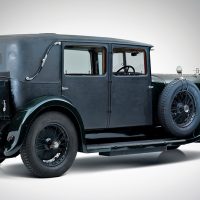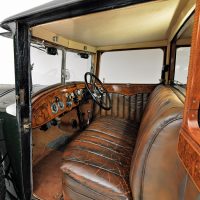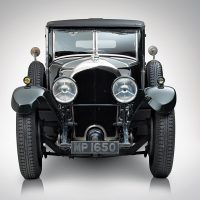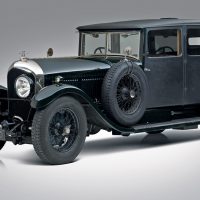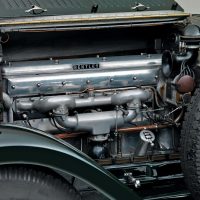SCM Analysis
Detailing
| Vehicle: | 1928 Bentley 6½ Litre Four-Light Weymann Fabric Sports Saloon |
| Years Produced: | 1926–30 |
| Number Produced: | 544 |
| Original List Price: | $1,450 (chassis and drivetrain) |
| SCM Valuation: | $561,000 |
| Chassis Number Location: | On front engine cross member |
| Engine Number Location: | Stamped into engine bearer integral with crankcase |
| Club Info: | Bentley Drivers Club |
| Website: | http://www.bdcl.org |
| Alternatives: | 1925–31 Rolls-Royce New Phantom, 1919–33 Hispano-Suiza H6, 1926–30 Auburn 8-88/115/120 |
| Investment Grade: | A |
This car, Lot 237, sold for $1,304,675, including buyer’s premium, at Bonhams’ Grand Palais auction in Paris during Rétromobile week.
There’s almost no such thing as an original Bentley. When such a rare beast breaks cover, it reopens speculation on the price of unicorn horn.
In period, the factory would mix and match components in the course of normal servicing and accident repair. The work was usually detailed in the handwritten chassis records still available as copies from the Bentley Drivers Club.
Such parts swapping is (usually) very transparent, completely accepted and even encouraged in the case of the prized 3 and 4½s, which are 3 Litres using 4½ Litre engine blocks (actually 4,398 cc) for more grunt.
The blocks swap right over, and because the engine number is stamped into one of the bearers cast into the crankcase, the car retains its entire original identity. Some of these 3 and 4½s are actually 5.3 liters by now, but that’s another story.
A prized, nearly original car
Nevertheless, in Bentley hierarchy, original cars — especially original cars with competition history — are the most prized.
Cars with most of their original components and still with their original bodies — restored or not — are next.
Those still having three or four out of five of the major mechanical components originally installed at Cricklewood — chassis, engine, gearbox, rear axle, steering column — come a notch further down.
At the bottom of the pile are bitsas built up later from parts, perhaps around a replica chassis — though that’s not to condemn them. The factory changed quite a few cars in period due to accident damage.
These built-up cars include barking-mad hot rods with supercharged 8 Litre “Sixes” stuffed into a short 3 Litre chassis. All are highly desirable and highly regarded — except the 4 Litres, but most of those have been made into 8 Litres with new engines anyway.
All of them go pretty well for cars nearing 100 years old.
Negotiating your way around the gearbox, with its right-hand, non-synchro shift — they’re all subtly different — has been elevated to an art form. However, the super-slick shift of a well-honed Bentley ’box is an experience of joy — and one of nature’s wonders.
Other original Bentleys
In 2015 at Beaulieu, Bonhams sold an incredibly original 1929 4½ Litre steel-bodied Mulliner saloon that looked dilapidated.
In fact, the car was in good mechanical order. The doors still fitted and closed beautifully, and the original leather was savable. It had been in the same family ownership since 1935 and wore BDC and Caravan Club badges as it had been used for towing.
An original car like this one comes along very rarely, and they always send enthusiasts into an “only original once” frenzy.
If you suggested to a Bentley fancier that it would have benefited from restoration, he or she might have stared at you sternly — or downwardly revised their opinion of you to the sort of chap who buys his own furniture.
That Bentley sold for the huge — but entirely expected — sum of $1,059,595, around 50% more than a decent 4½ was getting then. It was offered for sale again in 2018 for £950k (then about $1.3 million) after being recommissioned and gently used for a couple of years.
Our subject 6½ Litre car was cosmetically sharper — but almost as original.
Period photos prove the pudding
Photographs of our subject Bentley when new in the auction catalog show it looking almost identical to the way it does today — save for the deletion of the bumpers and the slatted vents on each side above the running boards. The rear trunk is now in a slightly different, smaller style.
The front-seat leather was replaced in the 1960s, and is now nearly as patinated as the rest of the car. It had an engine rebuild in 2003, at Blackmore Engineering.
In more recent times, the Bentley has been on museum display in Germany — and was little used, which led to the decision to sell. However, according to www.vintagebentleys.org, it had a new owner in 2017.
It took just over a million quid, as expected, although it hammered €200k under the pre-sale estimate for a round million euros, or €1.15m with premium.
Selling 20% behind the lower estimate — near where the reserve usually lies — has become quite normal at European auctions in the past two years since the dreaded Brexit vote I am weary of mentioning.
This might still look like a lot of money, but $1.3 million is no blip. A 6½ Litre with its original Barker touring body sold for $1.7 million at Bonhams’ Quail Lodge sale last August.
The bottom line here is take the money fetched by that very original 4½ Litre sold at Beaulieu in 2015, then add up to 50% for two more cylinders. Although it looks like a slightly scary sum for a vintage Bentley without Le Mans racing history, the price paid is right. ♦
(Introductory description courtesy of Bonhams.)
